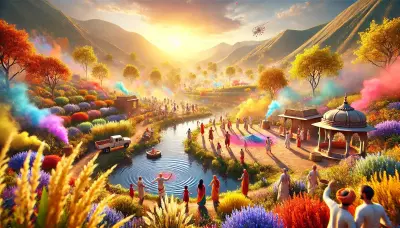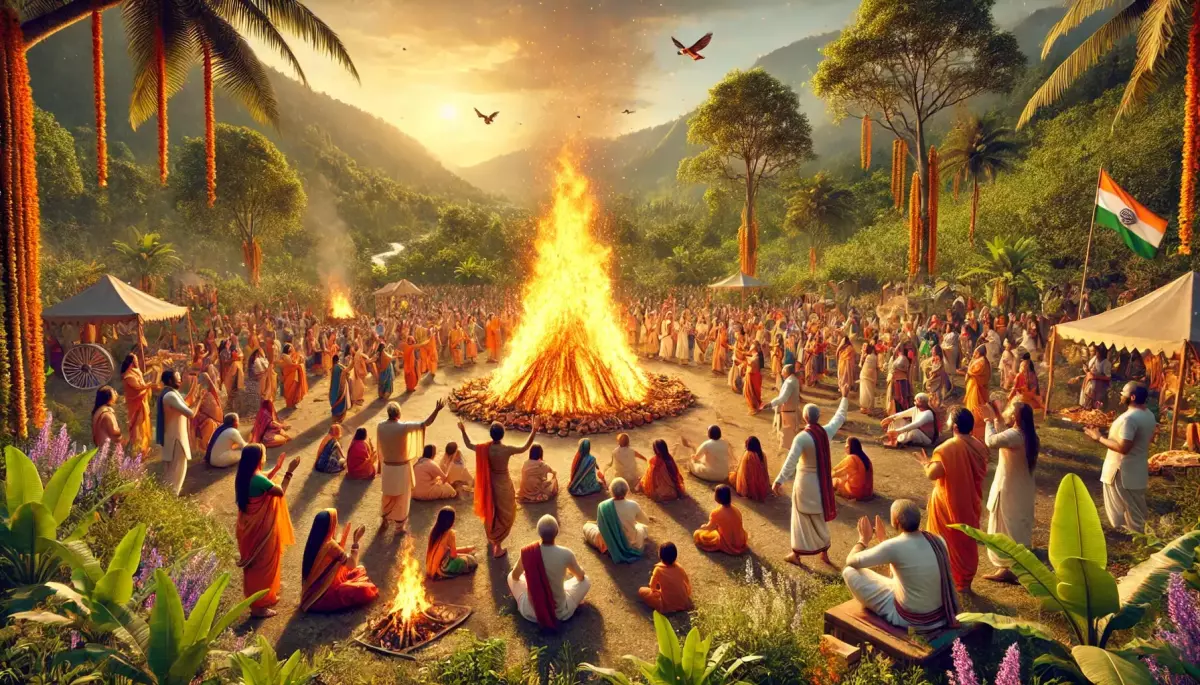Holika Dahan is a vibrant celebration that marks the beginning of the Holi festival, one of the most anticipated events in Indian culture. On this special day, communities gather around bonfires that symbolize the victory of good over evil. This ritual, which takes place on the night before Holi, is filled with meanings and traditions, reflecting the rich cultural heritage of India.
During Holika Dahan, people offer prayers, sing folk songs, and dance around the bonfire. The flame, which represents the destruction of the demoness Holika, is a powerful symbol of renewal and hope. Furthermore, it is a perfect moment to strengthen family and community bonds, creating memories that will last a lifetime.
Holika Dahan brings everyone together in celebration. It is a wonderful opportunity to reflect on the challenges overcome and renew the commitment to goodness and harmony. If you have not yet participated in this magical celebration, now is the perfect time to get involved and discover the beauty of this unique tradition!
Meaning and Origin of Holika Dahan
Holika Dahan is an important festival in the Hindu calendar, celebrated mainly in India, marking the beginning of spring and the victory of good over evil. The event takes place on the night before the Holi festival, which is known for its vibrant colors and joyful celebrations. Holika Dahan symbolizes the burning of the demon Holika, who, according to Hindu mythology, tried to destroy the devotee Prahlad, a fervent follower of the god Vishnu. This victory is a powerful reminder of the importance of faith and devotion.
The origin of Holika Dahan dates back to ancient stories that are deeply rooted in Hindu traditions and mythologies. The celebration is generally associated with the Holi festival, which occurs throughout the country, but Holika Dahan has a special significance as it symbolizes the beginning of the festivities. On the day of the celebration, people gather to light bonfires, which represent the destruction of evil and the rebirth of good. These bonfires are often made of wood, dry leaves, and other materials, forming heaps that are burned at night.
👉 Download the Calendar for 2025
Full Calendar of Holika Dahan until 2050
Next Event
Republic Day - 01/26/2026| Year | Next Date |
|---|---|
| Holika Dahan in 2026 | 03/02/2026 |
| Holika Dahan in 2034 | 03/03/2034 |
| Holika Dahan in 2042 | 03/03/2042 |
| Holika Dahan in 2050 | 03/03/2050 |
| Holika Dahan in 2031 | 03/06/2031 |
| Holika Dahan in 2039 | 03/06/2039 |
| Holika Dahan in 2047 | 03/06/2047 |
| Holika Dahan in 2023 | 03/07/2023 |
| Holika Dahan in 2028 | 03/08/2028 |
| Holika Dahan in 2044 | 03/08/2044 |
| Holika Dahan in 2020 | 03/09/2020 |
| Holika Dahan in 2036 | 03/09/2036 |
| Holika Dahan in 2025 | 03/14/2025 |
| Holika Dahan in 2033 | 03/14/2033 |
| Holika Dahan in 2041 | 03/14/2041 |
| Holika Dahan in 2049 | 03/14/2049 |
| Holika Dahan in 2022 | 03/17/2022 |
| Holika Dahan in 2030 | 03/17/2030 |
| Holika Dahan in 2038 | 03/17/2038 |
| Holika Dahan in 2046 | 03/17/2046 |
| Holika Dahan in 2027 | 03/21/2027 |
| Holika Dahan in 2035 | 03/21/2035 |
| Holika Dahan in 2043 | 03/21/2043 |
| Holika Dahan in 2024 | 03/25/2024 |
| Holika Dahan in 2032 | 03/25/2032 |
| Holika Dahan in 2040 | 03/25/2040 |
| Holika Dahan in 2048 | 03/25/2048 |
| Holika Dahan in 2021 | 03/28/2021 |
| Holika Dahan in 2029 | 03/28/2029 |
| Holika Dahan in 2037 | 03/28/2037 |
| Holika Dahan in 2045 | 03/28/2045 |
Rituals and Associated Traditions
The Holika Dahan rituals involve several symbolic practices that are significant for the devotees. On the eve of the festival, communities gather to light the bonfire, offering prayers and chants in honor of Vishnu. During the ceremony, participants offer grains, flowers, and other items to the fire, symbolizing purification and the release of negative energies. This practice is accompanied by rituals that include the recitation of mantras and the performance of pujas (worship rituals).
👉 Download the Calendar for 2025
Another important tradition during Holika Dahan is the construction of representations of Holika, which are burned in the bonfire. Children and adults also often dance around the bonfire, celebrating the victory of good over evil. The burning of Holika is a moment of great joy and festivity, where people gather to share stories and family traditions. In addition, many communities hold celebrations that include music and dance, creating a festive atmosphere that brings people together.
Celebrations in Different Regions of India
The celebrations of Holika Dahan vary significantly between different regions of India. In northern India, especially in states like Uttar Pradesh and Punjab, the festivity is marked by large bonfires and community celebrations. People gather in public squares to light the bonfires, dance, and sing, creating a vibrant and festive atmosphere. Local traditions often include the participation of folk dance groups and live music, highlighting the rich cultural diversity of the region.
In southern India, although Holika Dahan is not as widely celebrated, some communities still recognize the importance of the festival, performing rituals on a smaller scale. Celebrations in the south tend to be more subdued, focusing on prayers and family celebrations at home. However, the essence of the festival, which is the victory of good over evil, remains present, reflecting the cultural unity of the country. In contrast, in the western region, especially in Gujarat, the festivities include traditional dances and community events, where people gather to celebrate the occasion.
Cultural and Social Impact of Holika Dahan
Holika Dahan is not just a religious celebration but also an event that plays a significant role in the social and cultural cohesion of communities. During this time, people set aside their differences and come together to celebrate unity and brotherhood. The ritual of lighting the bonfire provides an opportunity for people to meet, share stories, and strengthen community bonds. This social aspect is particularly important in a diverse country like India, where peaceful coexistence among different cultures is vital.
👉 Download the Calendar for 2025
Moreover, Holika Dahan also plays an important role in educating new generations about traditions and cultural values. Children learn about the history behind the festival and the symbolic meanings associated with it. These lessons help to transmit India's rich cultural heritage from one generation to another, preserving traditions and promoting a sense of identity among the youth.
The impact of Holika Dahan can also be seen in terms of tourism and the local economy. Many towns and villages organize festivals and special events to attract visitors during this time of the year, generating revenue for local communities. Cultural tourism associated with Holika Dahan helps promote India's cultural diversity, allowing people from around the world to experience local traditions and celebrations. This not only benefits the economy but also strengthens India's image as a culturally and historically rich tourist destination.
Typical Recipes for the Celebration
During Holika Dahan, it is common for families to prepare a variety of traditional dishes and sweets to celebrate the festival. One of the most popular dishes is "gujiya," a type of pastry filled with a sweet mixture of grains and dried fruits. These pastries are often fried until golden and crispy, being a much-appreciated delicacy during the celebrations. Moreover, gujiya is a symbol of joy and celebration, reflecting the festive spirit of Holi and Holika Dahan.
Another typical dish is "puran poli," a kind of pancake filled with a mixture of chickpeas and sugar. This recipe is quite popular in various regions of India and is often served during religious festivities. Puran poli is carefully prepared, and its sweetness represents the happiness and prosperity that the festival brings to families.
In addition to the main dishes, families also tend to prepare a variety of snacks and appetizers to share with friends and neighbors. Among these, "namkeen" (savory snacks) and "dahi vada" (lentil dumplings in yogurt sauce) are popular. These tasty delicacies are often served during the celebrations, providing a delicious feast that brings people together around the table. The cuisine during Holika Dahan is an essential part of the celebration, reflecting the culture and traditions of the community.
Conclusion
Holika Dahan is a vibrant celebration that symbolizes the victory of good over evil, and its cultural importance is undeniable. Over the years, this festivity has brought together families and friends, promoting harmony and joy among the participants. With its blazing bonfires and meaningful rituals, Holika Dahan reminds us of the power of unity and hope.
👉 Download the Calendar for 2025
As we reflect on the importance of Holika Dahan, it is essential to remember that this festivity goes beyond traditions. It invites us to be reborn, to leave behind what prevents us from evolving, and to embrace new opportunities. Therefore, as you celebrate, do not forget to share the message of love and hope with those around you.
In summary, Holika Dahan is a celebration that inspires us to live with more intensity and gratitude. May each flame reignite in our hearts the desire for a bright future filled with joys. Don’t miss the chance to experience this magical event and share unforgettable moments!

